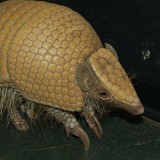RANGE
Indian Subcontinent (India and Sri Lanka)
HABITAT
Deciduous forest, dry savannas, semi-arid grasslands. Also in human-altered habitats including waste areas, deserts, scrub lands, plantations.
SIZE
Males are about 6 inches long. Females are much larger than males with broader shells. They are about 10 inches long. Hatchlings are 32 to 40 mm long. Eggs are about 1.8 inches long and 1.4 inches wide.
LIFE EXPECTANCY
At least 75 years.
REPRODUCTION
Star tortoises reach sexual maturity at about 6 to 7 years of age. Mating occurs during the rainy season (mid-June to mid-October). Females lay three to six eggs which incubate 47 to 147 days. They may lay two to threee clutches per year.
DIET
Chiefly herbivorous. Requires a coarse high fiber diet. Like water more than any other species of this genus.
Wild: Eats grass, vegetation, fallen fruit or flowers, and occasionally snails.
Zoo: Chopped greens, carrots, assorted vegetables, orchard grass, tortoise chow.
BEHAVIOR
- Males may attempt to turn each other over on their backs during breeding season.
- Females urinate on sand as she excavates nest.
- Likes to soak in shallow water.
- Most feeding and mobility takes place in the early morning and late afternoon.
- May hide under bushes or tufts of grass.
POINTS OF INTEREST
- Egg shells are very hard, dotted with numerous widely spaced pores.
- Hatchlings lack “star” marks on shell.
- There are two distinct color variations: orange with yellow vertebral stripe and yellow form without stripe.
- It is the smallest Geochelone species.
STATUS
Was once one of the most familiar tortoises in captivity, but quite rare now because it is eaten by local people and it is susceptible to pneumonia and other respiratory diseases.





